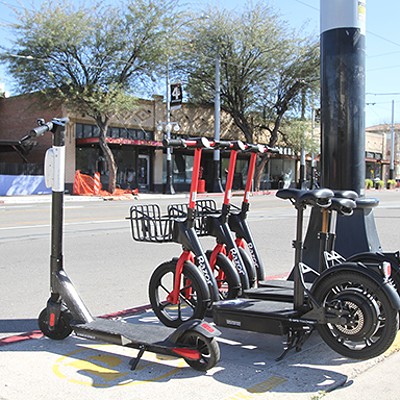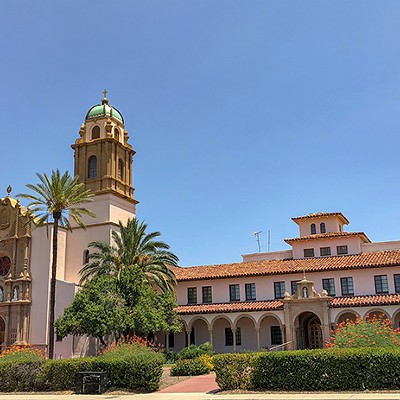Condemned by contrasting notions of progress, the empty buildings dot Broadway Boulevard's northern flanks like a melancholy death row, their windows vacant, their signs faded into oblivion.
Purchased by the city over the past two decades, they've long been slated for demolition, collateral damage in an ambitious plan to widen Broadway between Euclid Avenue and Country Club Road.
But these woebegone properties recently won a reprieve, of sorts, when a citizens' task force challenged whether Broadway's remaking must include an expansion dooming them to demolition.
Instead, the task force is compelling a fresh definition of what voters were seeking in 2006, when they approved this project as part of a sweeping, 20-year regional transportation plan.
The vast nature of that plan left out much of the fine print—such as the fact that the supposed need for widening Broadway to 150 feet is based on 25-year-old, potentially flawed traffic projections. Or that such construction will lead to the demolition of more than 100 homes, businesses and historic properties.
Then there's the price tag: Total budgets for the project top $71 million, with $42 million of that coming from the Regional Transportation Authority; $25 million from Pima County transportation bonds; $1.2 million from the Pima Association of Governments; and $3 million from the city of Tucson.
Into that breach has stepped the task force, which finds itself in the midst a political fracas over competing visions of Broadway. One vision sees the arterial as a vast sea of concrete. The other imagines a corridor with mass transit, welcoming to walkers and bicyclists, and narrow enough that the thriving business district on its north side won't be totally decimated.
In the meantime, however, buildings along that north side continue to deteriorate. Even those still inhabited are starting to decline, with their owners showing little appetite for renovating properties that may be paved over.
This conundrum has not gone unnoticed by Tucson City Councilman Steve Kozachik, whose Ward 6 encompasses the Broadway project. Several weeks ago, he commenced an aggressive push to have the city-owned buildings put to good use by renting them out. But he quickly discovered that few businesses want to rent buildings with such a shaky future.
To Kozachik, the city needs to either make a decision now to widen Broadway, or choose to keep it within the current boundaries. He sees the alternative—leaving these buildings and their owners in limbo for another year—as no alternative at all.
Kozachik blasted his first hole in the status quo on Dec. 7, when he persuaded the council to transfer right-of-way acquisition funds—currently around $2 million—to the design and planning aspects of Broadway's facelift. While that's gravy to the legion of consultants feeding off this project, it also means there's no more money for the city to buy squat.
But old habits die hard; the Broadway task force's Dec. 13 meeting began with a consultant describing how the city would buy properties that are blocking progress: These purchases can be voluntary, or forcible through eminent domain.
Rocco DiGrazia glanced at a glossy acquisition pamphlet put out by the city. DiGrazia owns the popular Rocco's Little Chicago Pizzeria on Broadway's precarious north side, and represents fellow business people as a task-force member. He leafed through the pamphlet, promising to share it with his colleagues.
That prompted Colby Henley to uncross his arms and sit up. Henley represents the Rincon Heights Neighborhood, sandwiched between Broadway and Sixth Street. "I would just ask, Rocco, that when you provide these, just explain that it's not a foregone conclusion that any acquisition's going to happen," he said.
"Oh, I always tell them that," DeGrazia replied.
Soon came a caveat from Broadway project-manager Jenn Toothaker Burdick. "This project started out with a 150-foot right-of-way alignment," she said. "It was something that was approved in 1987, and again through the 2006 RTA vote.
"But the process we're undergoing right now is not limited to only looking at that," she continued. "We're all really looking at what is the most-appropriate thing to put in this 2-mile segment that meets the function of what Broadway is."
In the audience, Kozachik was apoplectic. Eventually, he handed me a note intimating that this dance over Broadway's future width needed to stop. "Nobody has any incentive to invest in their property with that potential 'taking' hanging over their head," he wrote. "We've created blight by already buying nearly $7 million in property."
Contacted later by phone, the councilman was still fired up. "What's pissing me off so much is they keep talking about eminent domain, and the public purpose," he said. "But there is no public purpose until you've identified the need, and you can't do that until you've established the cross-width of the corridor. It's completely bass-ackwards."
Nonetheless, one big hurdle has been breached: Ever since the task force convened, the RTA has issued veiled threats to withhold its $42 million unless the project meets the threshold of "functionality" as defined in the 2006 bond vote. Until recently, functionality was seen as a boulevard expanded to a width of 150 feet. However, now even the RTA is beginning to bend.
"We've never asserted that '150-foot' is necessarily the be-all, end-all number," said RTA transportation director Jim DeGrood by phone. "We think we need to have an appropriate amount of right of way for whatever the facility is that we begin building."
In an earlier interview, however, DeGrood had been far more cagey about what might happen should the task force stray too far from the 2006 mandate. "From our standpoint, we have to go back and reconcile that against what we presented to the voters," he said.
When I called Toothaker Burdick after the meeting, she cautioned against Kozachik's goal of forcing a quick decision. Determining a width for Broadway "is the endgame," she said. "Part of the reason we created the task force was to evaluate the criteria. They have a lot of work to do, and we have to give them the time to do it."
Meanwhile, some of the Broadway properties already purchased by taxpayers sit empty. And it seems the city's buying spree could not have ended too soon; just last year, it picked up a former Allstate office on the 1200 block of East Broadway for just more than $218,000. Word is that few buyers seemed interested after learning that the building could face condemnation. After that, the property's value went into the tank. In the end, I'm told, the owner got low-balled by the city.
Call it collateral damage.












